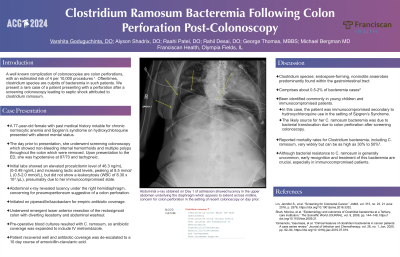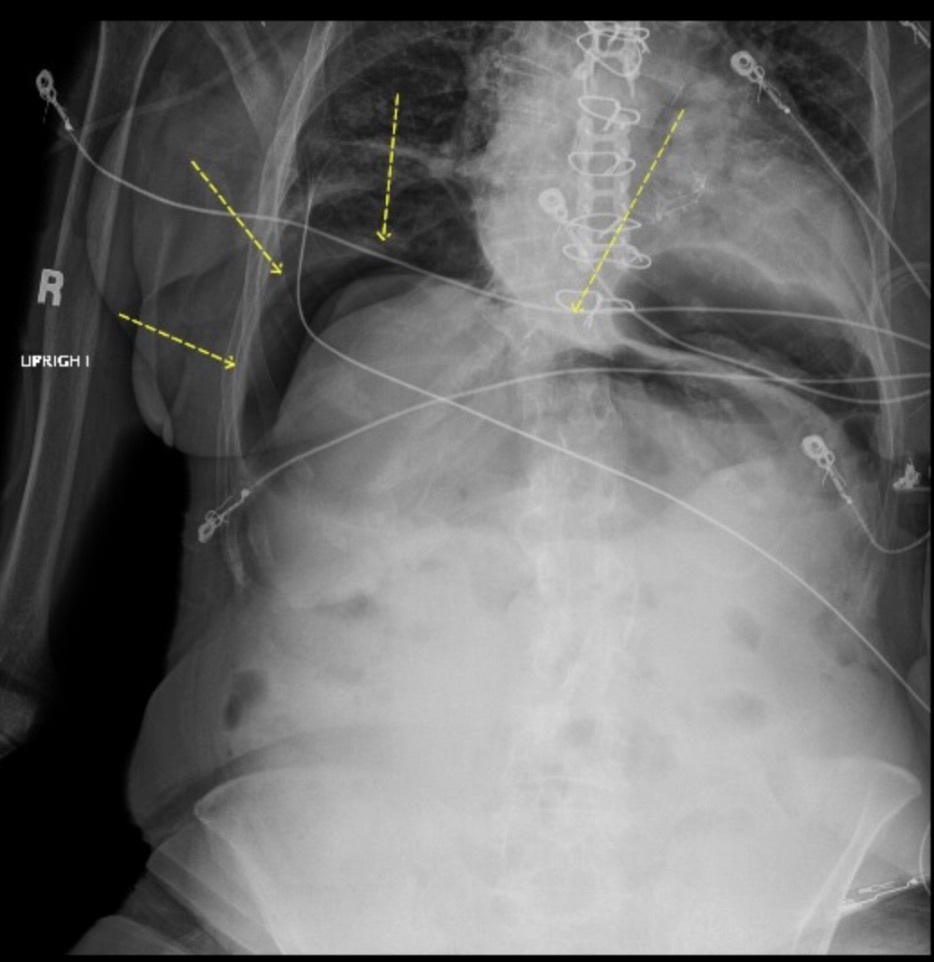Sunday Poster Session
Category: Colon
P0295 - Case Report: Clostridium ramosum Bacteremia Following Colon Perforation Post-Colonoscopy
Sunday, October 27, 2024
3:30 PM - 7:00 PM ET
Location: Exhibit Hall E

Has Audio
.jpg)
Varshita Goduguchinta, DO
Franciscan Health Olympia Fields
Chicago, IL
Presenting Author(s)
Varshita Goduguchinta, DO1, Alyson Shadrix, DO2, Raahi Patel, DO2, Rahil Desai, DO1, George Thomas, MBBS2, Michael Bergman, MD2
1Franciscan Health Olympia Fields, Chicago, IL; 2Franciscan Health Olympia Fields, Olympia Fields, IL
Introduction: A well known complication of colonoscopies are colon perforations, with an estimated risk of 4 per 10,000 procedures ¹. Oftentimes, clostridium species are culprits of bacteremia in such patients. We present a rare case of a patient presenting with a perforation after a screening colonoscopy leading to septic shock attributed to clostridium ramosum.
Case Description/Methods: A 77-year-old female with past medical history notable for chronic normocytic anemia and Sjogren’s syndrome on hydroxychloroquine presented with altered mental status. The day prior to presentation, she underwent screening colonoscopy which showed non-bleeding internal hemorrhoids and multiple polyps throughout the colon which were removed. Upon presentation to the ED, she was hypotensive at 87/70 and tachypneic. Initial labs showed an elevated procalcitonin level of 46.3 ng/mL (0-0.49 ng/mL) and increasing lactic acid levels, peaking at 8.5 mmol/L (0.5-2.0 mmol/L), but did not show a leukocytosis (WBC of 8.30 x 10³ /μL), presumably due to her immunocompromised state. Abdominal x-ray revealed lucency under the right hemidiaphragm, concerning for pneumoperitoneum suggestive of a colon perforation. Patient was initiated on piperacillin/tazobactam for empiric antibiotic coverage. General surgery was promptly consulted, leading to emergent lower anterior resection of the rectosigmoid colon with diverting ileostomy and abdominal washout. Pre-operative blood cultures resulted with C. ramosum, so antibiotic coverage was expanded to include IV metronidazole. Patient recovered well and antibiotic coverage was de-escalated to a 10 day course of amoxicillin-clavulanic acid.
Discussion: Clostridium species are endospore-forming, nonmotile anaerobes predominantly found within the gastrointestinal tract. This species makes up about 0.5-2% of bacteremia cases². Among this, C. ramosum bacteremia is especially rare and has been identified commonly in young children and immunocompromised patients. In this case, the patient was immunocompromised secondary to hydroxychloroquine use in the setting of Sjogren’s Syndrome. The likely source for her C. ramosum bacteremia was due to bacterial translocation due to colon perforation after screening colonoscopy. Reported mortality rates for Clostridium bacteremia, including C. ramosum, vary widely but can be as high as 30% to 50%³. Although bacterial resistance to C. ramosum is generally uncommon, early recognition and treatment of this bacteremia are crucial, especially in immunocompromised patients.

Disclosures:
Varshita Goduguchinta, DO1, Alyson Shadrix, DO2, Raahi Patel, DO2, Rahil Desai, DO1, George Thomas, MBBS2, Michael Bergman, MD2. P0295 - Case Report: <i>Clostridium ramosum</i> Bacteremia Following Colon Perforation Post-Colonoscopy, ACG 2024 Annual Scientific Meeting Abstracts. Philadelphia, PA: American College of Gastroenterology.
1Franciscan Health Olympia Fields, Chicago, IL; 2Franciscan Health Olympia Fields, Olympia Fields, IL
Introduction: A well known complication of colonoscopies are colon perforations, with an estimated risk of 4 per 10,000 procedures ¹. Oftentimes, clostridium species are culprits of bacteremia in such patients. We present a rare case of a patient presenting with a perforation after a screening colonoscopy leading to septic shock attributed to clostridium ramosum.
Case Description/Methods: A 77-year-old female with past medical history notable for chronic normocytic anemia and Sjogren’s syndrome on hydroxychloroquine presented with altered mental status. The day prior to presentation, she underwent screening colonoscopy which showed non-bleeding internal hemorrhoids and multiple polyps throughout the colon which were removed. Upon presentation to the ED, she was hypotensive at 87/70 and tachypneic. Initial labs showed an elevated procalcitonin level of 46.3 ng/mL (0-0.49 ng/mL) and increasing lactic acid levels, peaking at 8.5 mmol/L (0.5-2.0 mmol/L), but did not show a leukocytosis (WBC of 8.30 x 10³ /μL), presumably due to her immunocompromised state. Abdominal x-ray revealed lucency under the right hemidiaphragm, concerning for pneumoperitoneum suggestive of a colon perforation. Patient was initiated on piperacillin/tazobactam for empiric antibiotic coverage. General surgery was promptly consulted, leading to emergent lower anterior resection of the rectosigmoid colon with diverting ileostomy and abdominal washout. Pre-operative blood cultures resulted with C. ramosum, so antibiotic coverage was expanded to include IV metronidazole. Patient recovered well and antibiotic coverage was de-escalated to a 10 day course of amoxicillin-clavulanic acid.
Discussion: Clostridium species are endospore-forming, nonmotile anaerobes predominantly found within the gastrointestinal tract. This species makes up about 0.5-2% of bacteremia cases². Among this, C. ramosum bacteremia is especially rare and has been identified commonly in young children and immunocompromised patients. In this case, the patient was immunocompromised secondary to hydroxychloroquine use in the setting of Sjogren’s Syndrome. The likely source for her C. ramosum bacteremia was due to bacterial translocation due to colon perforation after screening colonoscopy. Reported mortality rates for Clostridium bacteremia, including C. ramosum, vary widely but can be as high as 30% to 50%³. Although bacterial resistance to C. ramosum is generally uncommon, early recognition and treatment of this bacteremia are crucial, especially in immunocompromised patients.

Figure: Erect abdominal x-ray demonstrating lucency of the upper abdomen underlying the right diaphragm, concerning for pneumoperitoneum.
Disclosures:
Varshita Goduguchinta indicated no relevant financial relationships.
Alyson Shadrix indicated no relevant financial relationships.
Raahi Patel indicated no relevant financial relationships.
Rahil Desai indicated no relevant financial relationships.
George Thomas indicated no relevant financial relationships.
Michael Bergman indicated no relevant financial relationships.
Varshita Goduguchinta, DO1, Alyson Shadrix, DO2, Raahi Patel, DO2, Rahil Desai, DO1, George Thomas, MBBS2, Michael Bergman, MD2. P0295 - Case Report: <i>Clostridium ramosum</i> Bacteremia Following Colon Perforation Post-Colonoscopy, ACG 2024 Annual Scientific Meeting Abstracts. Philadelphia, PA: American College of Gastroenterology.
